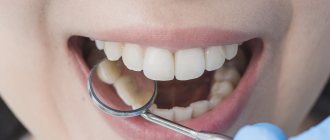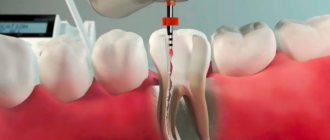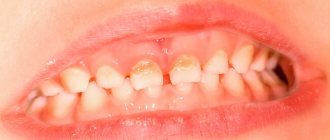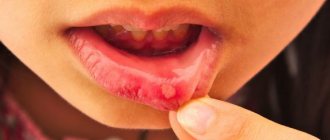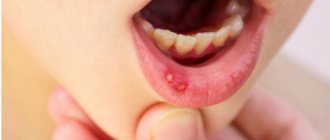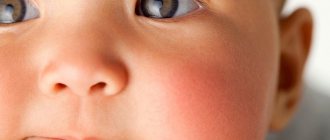Pulpitis is an inflammation of the internal structure of the tooth - the neurovascular bundle. In the vast majority of cases, this disease is caused by caries: many parents believe that there is no need to treat it, because baby teeth need to be replaced soon. However, this statement is not true, because unnoticed caries in time causes caries and inflammation of the pulp.
Primary molars, especially the lower ones, are more susceptible to this. This is due to the relatively thinner enamel - the infectious process reaches the internal structures of the tooth faster. For the same reason, pulpitis in children develops much faster than in adults.
Causes of pulpitis in children
Do not treat caries on time. Under the influence of caries, the tooth is gradually destroyed, and bacteria sooner or later penetrate into the pulp, causing its inflammation. Because the enamel and dentin of baby teeth are so thin, tooth decay can sometimes lead to pulpitis in a few months or even weeks—very quickly. In addition, the situation is complicated by the fact that parents often do not pay attention to childhood caries, since “the teeth will soon fall out anyway.”
Injury to a baby tooth. This often happens during play: the child hits his face and the teeth appear intact, but in fact the root or pulp is damaged. As a result of trauma, pulpitis can develop even in a tooth that looks completely healthy on the outside.
Medical error in the treatment of caries. Because a child's pulp is so close to the surface of the tooth, it is easy to accidentally damage the tissue and expose the pulp chamber during normal decay. And even in the absence of lesions, the pulp can catch fire simply due to exposure to filling material, too strong an antiseptic, and even overheating during treatment. Most often, this happens when a child is treated by an inexperienced dentist or an “adult” doctor who is not accustomed to working with baby teeth.
Acute infection. Sometimes bacteria enter the pulp not from the outside, but from the inside, through the blood. This happens if a child suddenly falls ill with something, for example, a sore throat. This kind of “internal” pulpitis is rare, but you need to know that it can link a recent illness and toothache over time.
Reasons causing the development of pulpitis
The main reasons that contribute to the appearance of pulpitis in children include:
Infectious pulpitis (most often as a complication of caries);
Traumatic (with a fracture of the coronal part of the tooth, accompanied by opening of the pulp chamber);
Iatrogenic (provoked by the dentist) pulpitis. It is observed when the pulp is accidentally opened while using a drill or when the pulp overheats due to insufficient cooling of the hard tissues of the tooth.
Symptoms of childhood pulpitis
Acute pulpitis. Types and symptoms
Acute pulpitis in children is rarely diagnosed. This is due to the fact that due to the structural features of milk teeth (in particular, the root system), it very quickly becomes chronic. The acute form has the most pronounced symptoms, so it is important that parents do not miss the moment and, if characteristic symptoms appear, immediately take the child for an examination to the dentist:
- Sudden severe toothache, worse at night.
- Painful sensations when pressing, eating, cold and heat.
- Weakness, headache, increased body temperature.
- Swelling in the area of the diseased tooth.
- Enlarged lymph nodes.
- Purulent discharge (rarely observed).
According to the degree of spread, acute pulpitis of primary teeth is divided into focal and diffuse. In the first case, the disease affects only a small area of the pulp, in the second - both the coronal and radical. It is almost impossible to detect pulpitis in the focal phase, since it covers the entire pulp of a baby tooth in a few hours. At an advanced stage, acute pulpitis can develop into the two most dangerous forms.
- Serous pulpitis. Occurs when serous fluid accumulates in the canals.
- Purulent pulpitis. This is a continuation of the serous phase. An accumulation of purulent exudate occurs in the pulp chamber, which can result in the formation of an abscess. Acute purulent pulpitis in children is usually accompanied by aching pain (may radiate to other parts of the jaw and head), fever and swelling of the tissue in the affected area.
Chronic pulpitis
Chronic pulpitis of primary teeth is usually the next acute stage, but can develop on its own due to caries, trauma or infectious disease. Chronic pulpitis in children is dangerous because it is practically asymptomatic. Acute pain and deterioration in general condition are often observed only in the acute stage. In the normal course of the disease, the pain is usually mild and intensifies when exposed to an irritant. Experts distinguish three types of chronic pulpitis, which occurs on both milk and molar teeth.
- Fibrous. The most common and mildest form of chronic pulpitis, in which the proliferation of fibrous tissue is diagnosed. Painful sensations are not expressed, but intensify with mechanical and thermal contact. The flesh may bleed a little.
- Hypertrophic. This form of chronic pulpitis is easy to diagnose due to the pathological proliferation of pulp tissue. It looks like a ball of granulation tissue filling most of the cavity. The crown of the tooth is usually severely damaged.
- Gangrenous. The most dangerous form. This type of pulpitis is often called advanced. Gangrenous pulpitis is accompanied by necrosis of the pulp in the coronary and root sections. With gangrenous pulpitis, the tooth often becomes gray, and as a result of tissue death, a characteristic bad breath occurs.
With the flow
Acute (focal and diffuse)
Acute pulpitis on baby teeth is quite rare, but requires surgical treatment in children. This is due to the fact that the process from focal (when only part of the pulp is affected) turns into diffuse within a few hours. Clinically, the disease is accompanied by severe arching pain that occurs when teeth come into contact with thermal irritants (cold, hot).
Chronic (fibrous, gangrenous and hypertrophic)
Chronic forms either result from an acute diffuse variant or develop primarily. The most common of these is fibrous pulpitis. It is found in both milk and permanent teeth. In the absence of timely treatment of chronic pulpitis in children, this type acquires a gangrenous form with signs of necrosis and pulp decay. The hypertrophic variant is rare and its peculiarity is the proliferation of pulp tissues and filling the carious cavity with them.
Incidence of pulpitis
Many parents do not take their children to the dentist, believing that pulpitis cannot develop in a child at 2 years of age. Mothers think that if they do not give crumbs of sweets, caries will not affect the enamel. Unfortunately, they are wrong. Dental pulpitis can be overcome by a child aged 2, 3 and 5 years.
At 2 years of age, the anterior milk teeth of the crocus are affected by pulpitis;
From 3-4 years of age, children more often suffer from pulpitis of the back teeth. Often a 4-5 year old child comes to the dentist crying from pain in his molars. Surprisingly, such inflammations occur several times more often than pulpitis of the front teeth in children.
Features of treatment of pulpitis of baby teeth
Unfortunately, it is not possible to cure pulpitis during a visit to the dentist even with modern means. Therapy is prescribed in several stages: initial examination, palpation of each tooth and tests. Depending on the degree of damage, two scenarios are possible: conservative and surgical treatment.
Conservative way
Suitable only for acute focal or fibrous stage, when there is no large lesion on the pulp, and you can do without a strong drug. After the initial examination, the procedure is carried out in several stages:
- Pain relief: one injection is enough; if the child is afraid of injections, the doctor can use pain-relieving gels.
- Cleaning channels and cavities, rinsing with antiseptic agents.
- Placement of medication, installation of temporary filling.
- Removal of temporary filling, re-treatment with antiseptic.
- Revision of tooth filling.
In most cases, physical therapy, such as electrophoresis, is prescribed to speed up the healing process.
The technique has a number of contraindications:
- Multiple caries - lesions on adjacent teeth must first be removed, otherwise treatment will not be beneficial - repeated infection will cause relapse.
- Congenital heart defects and other cardiovascular diseases that cause arrhythmias.
- Any infectious diseases: First of all, you need to undergo a course of treatment to eliminate them, then go to the dentist.
Surgical method
It consists of partial or complete removal of the pulp and cannot be carried out without it in most clinical situations when parents bring the child for examination too late. In general terms, the operating algorithm is always the same:
- Heavy local anesthesia is used.
- The tooth is opened with a drill or hand instrument.
- All areas affected by caries are cleaned, and dead areas of the pulp are removed with a scalpel.
- A medicinal paste is applied and the cavity is closed with a temporary filling.
- After 1-2 days, the filling is opened, if necessary, repeat cleaning with a drill and apply the medicinal paste again.
- The tooth is processed and filled.
Depending on the depth of damage to the root system, there are three effective methods of surgical intervention:
- Vital extrusion is the complete removal of the pulp. This is only possible in situations where there are no other alternatives and tissue necrosis threatens to move into the healthy area.
- Amputation is a compromise solution in which only part of the affected nerve is removed. This method is suitable for any form and stage of the disease, but only if the dentist is confident that the measures taken will lead to an effective result.
- Devital amputation is a similar type, provided that the pulp is removed using force. Previously, arsenic was used for this, now clinics will offer gentle means for laying a temporary filling for 48 hours, after which they will begin to directly remove dead tissue.
Treatment methods
The treatment of primary teeth in general does not differ from the treatment of permanent elements. If the child’s condition is serious, there is a threat of infection spreading throughout the body, amputation is performed. In most cases, the tooth is preserved to prevent malocclusion. Therapy is carried out in different ways:
- traditional. Involves treatment in three visits. During the first one, the nerve is opened, a devitalizing paste with arsenic is applied for 24-48 hours or without it for a period of up to 7 days. On the second visit, a pulp mummification mixture based on resorcinol-formalin is placed into the canals. At the last visit, a permanent filling is installed;
- modern. It takes place in 1 – 2 visits. If the child can sit quietly for a long time at the doctor and the roots of the tooth are formed, extraction is performed. The nerve is removed either on the first visit or after applying the paste. Next, the canals are carefully processed, infected tissue is removed, an anti-inflammatory paste (for example, zinc eugenol) is applied and closed with a filling. The composition will gradually dissolve along with the roots when changing teeth;
- partial vital amputation. The doctor removes the upper portion of the nerve and applies an antiseptic and anti-inflammatory medication that seals the remaining living pulp.
When treating teeth with immature roots, a different approach is chosen. This is due to several reasons:
- the apex of the roots has not yet closed and there is a risk of infection of the permanent tooth germ;
- the roots are short and the channels are wide;
- trauma to the upper zone of the root can lead to disturbances in its formation;
- It is impossible to remove the entire pulp and perform a complete canal treatment.
Most often, they choose amputation of the pulp by any method or biological treatment, when the tooth is cleaned of the affected tissue and a paste with calcium hydroxide is applied for several days. After this, a filling is installed.
Why is pulpitis dangerous for a child?
If pulpitis is not treated in time, the inflammation very quickly turns into a purulent form, accompanied by general intoxication of the body. Inflammation spreads to periodontal tissue and complications arise.
Complications of pulpitis of baby teeth can be:
- General intoxication of the body. Its symptoms are fever, fever, weakness, headache, sleep disturbance, and refusal to eat.
- Enlargement of the submandibular and retrouricular lymph nodes (lymphadenitis).
- Transition of the disease into a chronic course.
- Formation of fistulas on the gums next to the diseased tooth.
- Periodontitis is inflammation of the tissues surrounding the tooth, holding the tooth in the socket; periostitis (flux) is purulent inflammation of the periosteum.
- Sepsis is blood poisoning.
The difference between the pediatric form of pulpitis and the adult form
The main differences between pulpitis of primary teeth in children and permanent teeth are that:
- In temporary teeth, inflammatory processes occur much faster. Thus, pulp inflammation can become widespread within a few hours. This is due to the hyperergic types of reactions inherent in the child’s body, as well as the peculiarity of the blood supply to the pulp.
- In a shorter period of time, the carious process can lead to the development of inflammation in the neurovascular bundle. The reason lies in the larger pulp chamber, in the larger dentinal tubules through which the infection spreads faster, as well as in less mineralization.
- Pulpitis of a baby tooth is often asymptomatic and does not cause pain in children. A clear clinical picture is observed in permanent teeth. This is why chronic fibrous pulpitis is often encountered during the treatment of caries or during routine examinations in pediatric dentistry.
How to recognize the problem and is emergency treatment required?
Due to the reduced sensitivity of the pulp, pain during inflammation may be mild and not cause severe discomfort. In this case, the process of tissue destruction occurs rapidly. It is important to visit the dentist regularly and not ignore your child’s complaints of pain when chewing or when eating cold and hot foods.
Treatment for pulpitis should be immediate. The disease is dangerous due to complications - periodontitis or periostitis. It can also spread to a permanent tooth that has not yet erupted and destroy it.
How to prepare your child for treatment
Treatment of pulpitis of primary teeth in children is a rather complex task, so it is great if the child is already familiar with the dentist’s chair. The first visit should be preventive: familiarize yourself with the office environment, the doctor, and the tools.
In addition, the task of parents is to psychologically prepare the child. To do this you need:
- tell your child positively about doctors - say that the dentist treats teeth and makes sure they don’t hurt;
- plays dentist with toys and other family members;
- Avoid mentioning pain or dark or scary terms;
- do not deceive the child - explain that treating teeth may not be very pleasant, but it will not last long and the tooth will no longer hurt;
- remain calm, act gently but confidently if the child resists treatment;
- choose the right time to visit - it is best in the morning, when the child is alert and active;
- Bring a toy with you to calm your baby;
- give the doctor the opportunity to establish contact with the small patient - do not rush him;
- Do not scare the child under any circumstances, do not threaten, do not blackmail.
If the situation cannot be controlled in any way, you will have to reschedule the meeting for another day. However, the disease cannot be ignored: treatment of pulpitis of primary teeth in children must be carried out in one way or another. In special cases, the need for treatment under general anesthesia may be considered, but this should be discussed with your doctor.
Prevention of pulpitis in children
Pulpitis of primary teeth is difficult and expensive to treat, so it is best avoided. The following preventive measures will help with this:
- With the eruption of the first tooth, oral hygiene begins and gradually the child gets used to it.
- Brush children's teeth with special toothpastes containing age-appropriate fluoride.
- Avoid giving your child too many sweets, especially sugary drinks. The most dangerous thing is to feed your child sweets from a bottle: for this reason, the front teeth are often affected by caries, and then pulpitis.
- Make sure your child's diet includes plenty of fresh fruits and vegetables. Hard foods are especially beneficial: they strengthen teeth and help remove plaque.
- Every six months, take your child to the dentist for a preventive examination so that the doctor notices and treats caries in a timely manner.
- At the first sign of even minor tooth damage, do not let the process run its course, but take your child to the dentist.
These measures will help prevent pulpitis and keep your baby's milk and permanent teeth healthy.
